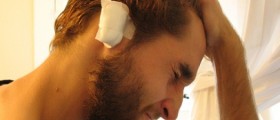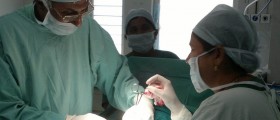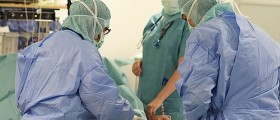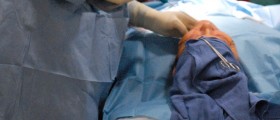
Complications after Dog SpaySpay is permanent form of sterilization of a female dog. Usually, spay is performed around the time the dog is six months old. Spay refers to surgical procedure known as ovariohysterectomy. Overiohysterectomy involves removal of both the uterus and the ovaries. This procedure is done to prevent the dog producing unwanted puppies. Spaying also benefits health and well being of an animal. This procedure reduces the risk of breast and mammary cancer and various disorders of reproductive tract, such as an infection of the uterus known as pyometra and uterine neoplasia. If female dogs are spayed before their first heat cycle, chance of developing mammary cancer decreases by 90%.
Spaying ProcedureBefore the procedure, the dog receives general anesthesia. The surgeon makes an incision in the middle of the abdomen and locates the reproductive tract. Then, the surgeon ties off both ovaries and observes transected tissue for bleeding. Uterus attaches are also tied off and cut and abdomen is checked for bleeding. The incision is closed with three layers of stitches by separately suturing internal muscle layer, subcutaneous tissue and outer skin. Sutures are usually absorbable and dissolve on their own but some surgeons choose non absorbable sutures that will have to be removed after several days.
Possible Complication This procedure is performed routinely and the complications are rare. However, possible complications include the risk of surgery and anesthesia, hemorrhage and wound infection. After ovariohysterectomy hormonal changes may occur due to removal of the reproductive organs and it can cause physical and mental changes in the dog. The dog may experience inability to withhold the urine because of lack of estrogen. Weight gain may occur as well. Other possible complications include suture reactions and infections, self-inflicted trauma and seroma. The risk of possible complications can be reduced with appropriate postoperative care but in case they occur inform your veterinarian as soon as possible. There is a possibility of separation of layers of the incision or dog may chew out the sutures.
Postoperative Care
For the first couple of days after spaying, the dog should rest and only go out to the bathroom. By limiting the dog’s activity, the risk of complications is minimized. For the next 7 to 14 days on-leash walking is allowed. The dog must not be allowed to run, jump or climb. Lampshade collar can prevent the dog from licking the sutures and the incision should be regularly checked for signs of swelling, redness or heat.

















Your thoughts on this
Loading...